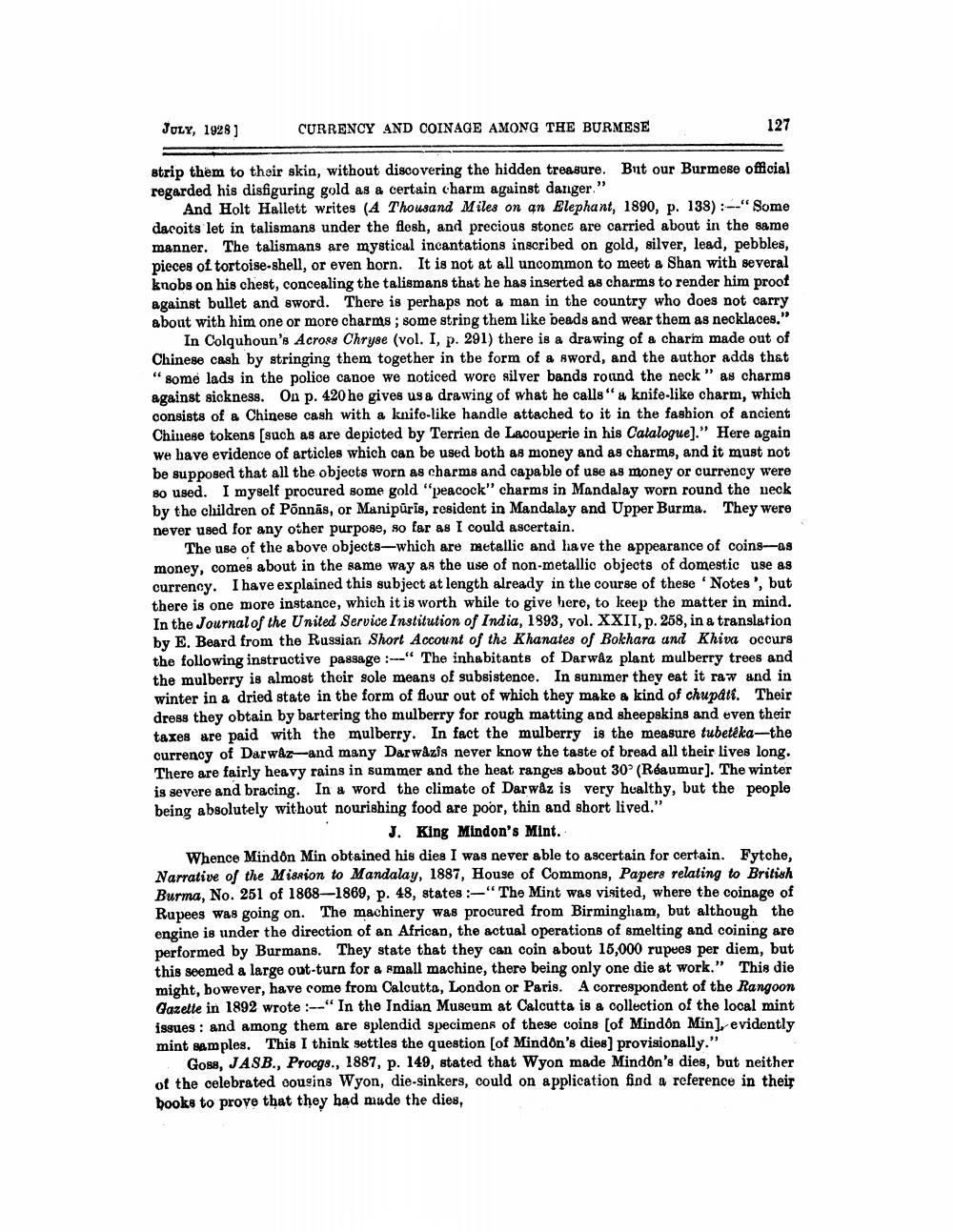________________
JULY, 1928)
CURRENCY AND COINAGE AMONG THE BURMESE
127
strip them to their skin, without discovering the hidden treasure. But our Burmese official regarded his disfiguring gold as a certain charm against danger."
And Holt Hallett writes (A Thousand Miles on an Elephant, 1890, p. 138) :-"Some dacoits let in talismans under the flesh, and precious stones are carried about in the same manner. The talismans are mystical incantations inscribed on gold, silver, lead, pebbles, pieces of tortoise-shell, or even horn. It is not at all uncommon to meet a Shan with several knobs on his chest, concealing the talismans that he has inserted as charms to render him proof against bullet and sword. There is perhaps not a man in the country who does not carry about with him one or more charms; some string them like beads and wear them as necklaces."
In Colquhoun's Across Chryse (vol. I, p. 291) there is a drawing of a charm made out of Chinese cash by stringing them together in the form of a sword, and the author adds that "some lads in the police canoe we noticed wore silver bands round the neck" as charms against sickness. On p. 420 he gives us a drawing of what he calls" a knife-like charm, which consists of a Chinese cash with a knife-like handle attached to it in the fashion of ancient Chinese tokens (such as are depicted by Terrien de Lacouperie in his Catalogue)." Here again we have evidence of articles which can be used both as money and as charms, and it must not be supposed that all the objects worn as charms and capable of use as money or currency were so used. I myself procured some gold "peacock" charms in Mandalay worn round the neck by the children of Ponnās, or Manipuris, resident in Mandalay and Upper Burma. They were never used for any other purpose, 90 far as I could ascertain.
The use of the above objects—which are metallic and have the appearance of coins-as money, comes about in the same way as the use of non-metallio objects of domestic use as currency. I have explained this subject at length already in the course of these Notes', but there is one more instance, which it is worth while to give here, to keep the matter in mind. In the Journal of the United Service Institution of India, 1893, vol. XXII, p. 258, in a translation by E. Beard from the Russian Short Account of the Khanates of Bokhara and Khiva occurs the following instructive passage :--" The inhabitants of Darwaz plant mulberry trees and the mulberry is almost their sole means of subsistence. In summer they eat it raw and in winter in a dried state in the form of flour out of which they make a kind of chupati. Their dress they obtain by bartering tho mulberry for rough matting and sheepskins and even their taxes are paid with the mulberry. In fact the mulberry is the measure tubeteka-the currency of Darwaz-and many Darwazis never know the taste of bread all their lives long. There are fairly heavy rains in summer and the heat ranges about 30' (Réaumur). The winter is severe and bracing. In a word the climate of Darwaz is very healthy, but the people being absolutely without nourishing food are poor, thin and short lived."
J. King Mindon's Mint. Whence Mindôn Min obtained his dies I was never able to ascertain for certain. Fytche, Narrative of the Mission to Mandalay, 1887, House of Commons, Papers relating to British Burma, No. 251 of 1868-1869, p. 48, states :-"The Mint was visited, where the coinage of Rupees was going on. The machinery was procured from Birmingham, but although the engine is under the direction of an African, the actual operations of smelting and coining are performed by Burmans. They state that they can coin about 16,000 rupues per diem, but this seemed a large out-turn for a small machine, there being only one die at work." This die might, bowever, have come from Calcutta, London or Paris. A correspondent of the Rangoon Gazette in 1892 wrote --"In the Indian Museum at Calcutta is a collection of the local mint issues : and among them are splendid specimens of these coins (of Mindôn Min), evidently mint samples. This I think settles the question (of Mindon's dios) provisionally."
Goss, JASB., Procg8., 1887, p. 149, stated that Wyon made Mindon's dies, but neither of the celebrated cougins Wyon, die-sinkers, could on application find a reference in their books to prove that they had made the dies,




